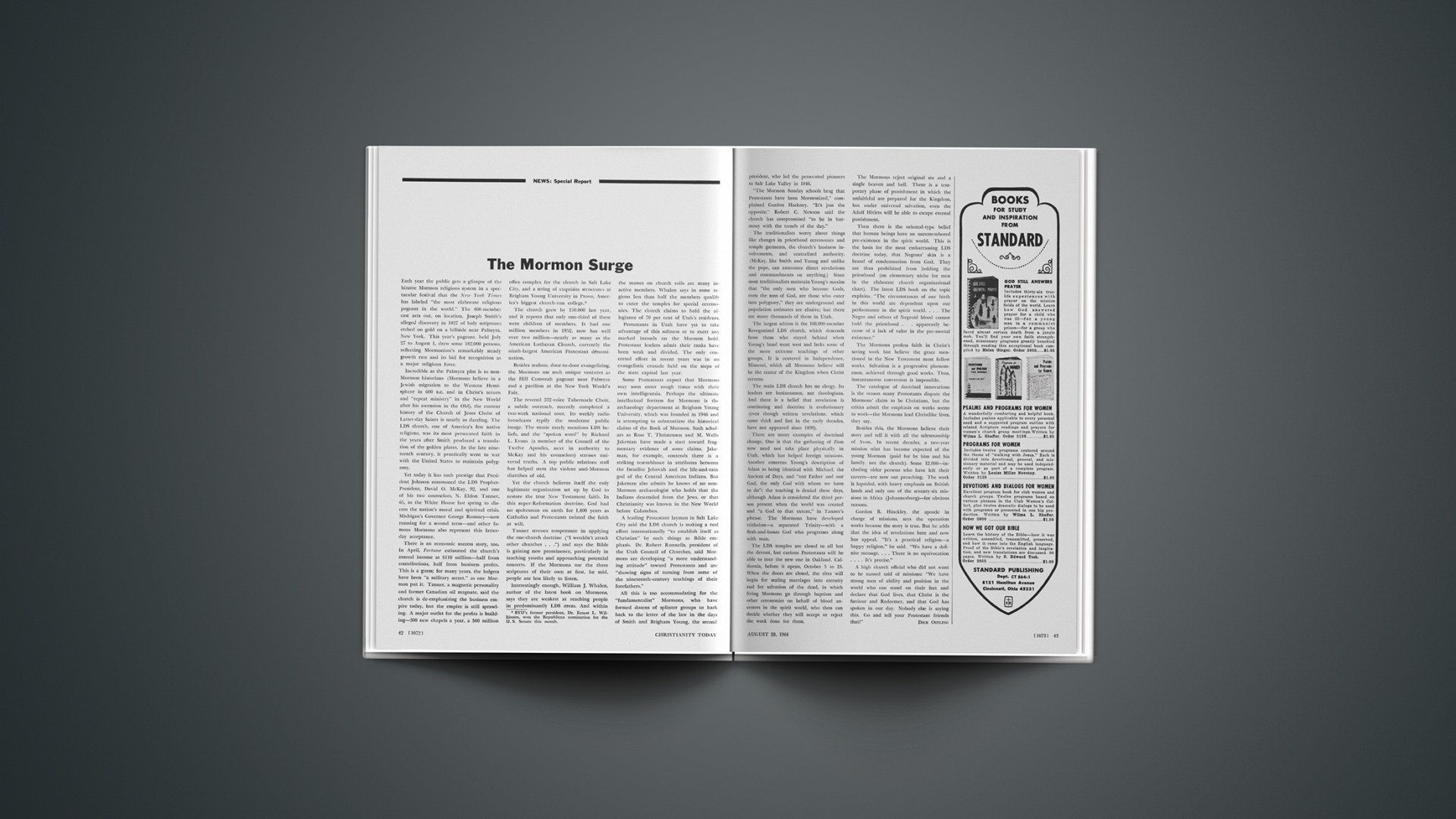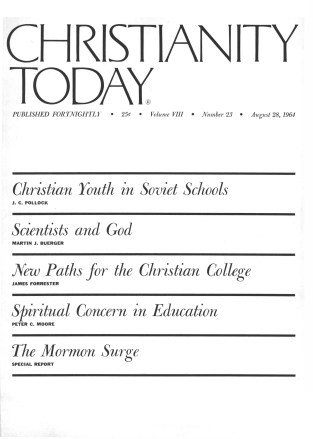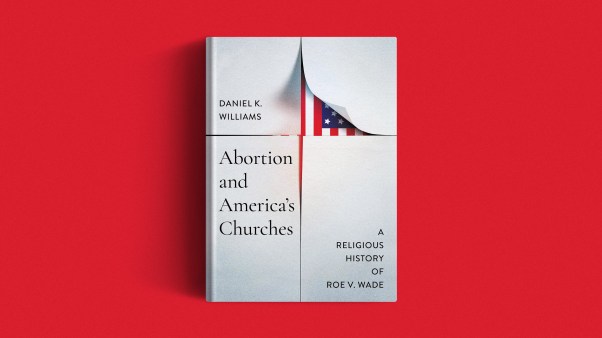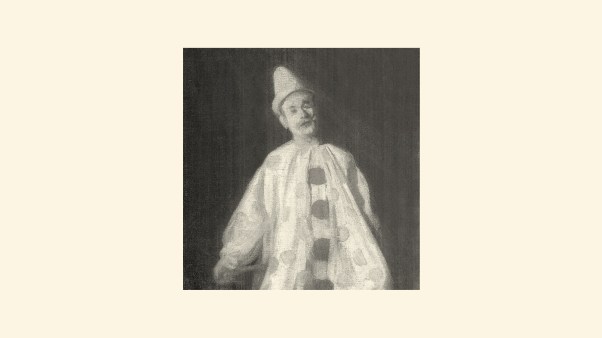Each year the public gets a glimpse of the bizarre Mormon religious system in a spectacular festival that the New York Times has labeled “the most elaborate religious pageant in the world.” The 400-membcr cast acts out, on location, Joseph Smith’s alleged discovery in 1827 of holy scriptures etched on gold on a hillside near Palmyra, New York. This year’s pageant, held July 27 to August 1, drew some 182,000 persons, reflecting Mormonism’s remarkably steady growth rate and its bid for recognition as a major religious force.
Incredible as the Palmyra plot is to non-Mormon historians (Mormons believe in a Jewish migration to the Western Hemisphere in 600 B.C. and in Christ’s return and “repeat ministry” in the New World after his ascension in the Old), the current history of the Church of Jesus Christ of Latter-day Saints is nearly as dazzling. The LDS church, one of America’s few native religions, was its most persecuted faith in the years after Smith produced a translation of the golden plates. In the late nineteenth century, it practically went to war with the United States to maintain polygamy.
Yet today it has such prestige that President Johnson summoned the LDS Prophet-President, David O. McKay, 92, and one of his two counselors, N. Eldon Tanner, 65, to the White House last spring to discuss the nation’s moral and spiritual crisis. Michigan’s Governor George Romney—now running for a second term—and other famous Mormons also represent this latter-day acceptance.
There is an economic success story, too. In April, Fortune estimated the church’s annual income at $110 million—half from contributions, half from business profits. This is a guess: for many years, the ledgers have been “a military secret,” as one Mormon put it. Tanner, a magnetic personality and former Canadian oil magnate, said the church is de-emphasizing the business empire today, but the empire is still sprawling. A major outlet for the profits is building—300 new chapels a year, a $60 million office complex for the church in Salt Lake City, and a string of exquisite structures at Brigham Young University in Provo, America’s biggest church-run college.1BYU’s former president, Dr. Ernest L. Wilkinson, won the Republican nomination for the U. S. Senate this month.
The church grew by 150,000 last year, and it reports that only one-third of these were children of members. It had one million members in 1952, now has well over two million—nearly as many as the American Lutheran Church, currently the ninth-largest American Protestant denomination.
Besides zealous, door-to-door evangelizing, the Mormons use such unique ventures as tire Hill Cumorah pageant near Palmyra and a pavilion at the New York World’s Fair.
The revered 332-voice Tabernacle Choir, a subtle outreach, recently completed a two-week national tour. Its weekly radio broadcasts typify the moderate public image. The music rarely mentions LDS beliefs, and the “spoken word” by Richard L. Evans (a member of the Council of the Twelve Apostles, next in authority to McKay and his counselors) stresses universal truths. A top public relations staff has helped stem the violent anti-Mormon diatribes of old.
Yet the church believes itself the only legitimate organization set up by God to restore the true New Testament faith. In this super-Reformation doctrine, God had no spokesman on earth for 1,400 years as Catholics and Protestants twisted the faith at will.
Tanner stresses temperance in applying the one-church doctrine (“I wouldn’t attack other churches …”) and says the Bible is gaining new prominence, particularly in teaching youths and approaching potential concerts. If the Mormons use the three scriptures of their own at first, he said, people are less likely to listen.
Interestingly enough, William J. Whalen, author of the latest book on Mormons, says they are weakest at reaching people in predominantly LDS areas. And within the masses on church rolls are many inactive members. Whalen says in some regions less than half the members qualify to enter the temples for special ceremonies. The church claims to hold the allegiance of 70 per cent of Utah’s residents.
Protestants in Utah have yet to take advantage of this softness or to exert any marked inroads on the Mormon hold. Protestant leaders admit their ranks have been weak and divided. The only concerted effort in recent years was in an evangelistic crusade held on the steps of the state capitol last year.
Some Protestants expect that Mormons may soon enter rough times with their own intelligentsia. Perhaps the ultimate intellectual fortress for Mormons is the archaeology department at Brigham Young University, which was founded in 1946 and is attempting to substantiate the historical claims of the Book of Mormon. Such scholars as Ross T. Thristensen and M. Wells Jakeman have made a start toward fragmentary evidence of some claims. Jakeman, for example, contends there is a striking resemblance in attributes between the Israelite Jehovah and the life-and-rain god of the Central American Indians. But Jakeman also admits he knows of no non-Mormon archaeologist who holds that the Indians descended from the Jews, or that Christianity was known in the New World before Columbus.
A leading Protestant layman in Salt Lake City said the LDS church is making a real effort internationally “to establish itself as Christian” by such things as Bible emphasis. Dr. Robert Runnells, president of the Utah Council of Churches, said Mormons are developing “a more understanding attitude” toward Protestants and are “showing signs of turning from some of the nineteenth-century teachings of their forefathers.”
All this is too accommodating for the “fundamentalist” Mormons, who have formed dozens of splinter groups to hark back to the letter of the law in the days of Smith and Brigham Young, the second president, who led the persecuted pioneers to Salt Lake Valley in 1846.
“The Mormon Sunday schools brag that Protestants have been Mormonized,” complained Gordon Hackney. “It’s just the opposite.” Robert C. Newson said the church has compromised “to be in harmony with the trends of the day.”
The traditionalists worry about things like changes in priesthood ceremonies and temple garments, the church’s business involvements, and centralized authority. (McKay, like Smith and Young and unlike the pope, can announce direct revelations and commandments on anything.) Since most traditionalists maintain Young’s maxim that “the only men who become Gods, even the sons of God, are those who enter into polygamy,” they are underground and population estimates are elusive; but there are many thousands of them in Utah.
The largest schism is the 160,000-member Reorganized LDS church, which descends from those who stayed behind when Young’s band went west and lacks some of the more extreme teachings of other groups. It is centered in Independence, Missouri, which all Mormons believe will be the center of the Kingdom when Christ returns
The main LDS church has no clergy. Its leaders are businessmen, not theologians. And there is a belief that revelation is continuing and doctrine is evolutionary (even though written revelations, which came thick and fast in the early decades, have not appeared since 1890).
There are many examples of doctrinal change. One is that the gathering of Zion now need not take place physically in Utah, which has helped foreign missions. Another concerns Young’s description of Adam as being identical with Michael, the Ancient of Days, and “our Father and our God, the only God with whom we have to do”: the teaching is denied these days, although Adam is considered the third person present when the world was created and “a God to that extent,” in Tanner’s phrase. The Mormons have developed tritheism—a separated Trinity—with a flesh-and-bones God who progresses along with man.
The LDS temples are closed to all but the devout, but curious Protestants will be able to tour the new one in Oakland, California, before it opens, October 5 to 24. When the doors are closed, the rites will begin for sealing marriages into eternity and for salvation of the dead, in which living Mormons go through baptism and other ceremonies on behalf of blood ancestors in the spirit world, who then can decide whether they will accept or reject the work done for them.
The Mormons reject original sin and a single heaven and hell. There is a temporary phase of punishment in which the unfaithful are prepared for the Kingdom, but under universal salvation, even the Adolf Hitlers will be able to escape eternal punishment.
Then there is the oriental-type belief that human beings have an unremembered pre-existence in the spirit world. This is the basis for the most embarrassing LDS doctrine today, that Negroes’ skin is a brand of condemnation from God. They are thus prohibited from holding the priesthood (an elementary niche for men in the elaborate church organizational chart). The latest LDS book on the topic explains, “The circumstances of our birth in this world are dependent upon our performance in the spirit world.… The Negro and others of Negroid blood cannot hold the priesthood … apparently because of a lack of valor in the pre-mortal existence.”
The Mormons profess faith in Christ’s saving work but believe the grace mentioned in the New Testament must follow works. Salvation is a progressive phenomenon, achieved through good works. Thus, instantaneous conversion is impossible.
The catalogue of doctrinal innovations is the reason many Protestants dispute the Mormons’ claim to be Christians, but the critics admit the emphasis on works seems to work—the Mormons lead Christlike lives, they say.
Besides this, the Mormons believe their story and tell it with all the salesmanship of Avon. In recent decades, a two-year mission stint has become expected of the young Mormon (paid for by him and his family, not the church). Some 12,000—including older persons who have left their careers—are now out preaching. The work is lopsided, with heavy emphasis on British lands and only one of the seventy-six missions in Africa (Johannesburg)—for obvious reasons.
Gordon B. Hinckley, the apostle in charge of missions, says the operation works because the story is true. But he adds that the idea of revelations here and now has appeal. “It’s a practical religion—a happy religion,” he said. “We have a definite message.… There is no equivocation.… It’s precise.”
A high church official who did not want to be named said of missions: “We have strong men of ability and position in the world who can stand on their feet and declare that God lives, that Christ is the Saviour and Redeemer, and that God has spoken in our day. Nobody else is saying this. Go and tell your Protestant friends that”
‘Ecclesiam Suam’
Pope Paul VI’s first encyclical, issued this month, reaffirmed unequivocally the Roman Catholic tenet of the primacy of the pontifical throne.
Many non-Catholics were taken aback because the encyclical emphasized the papacy despite a Vatican announcement that theological issues would not he treated—in deference to forthcoming Vatican Council sessions. Orthodox spokesmen interested in the ecumenical dialogue have insisted that the nature and dignity of the papacy must be discussable and debatable and not taken for granted, if there is to be a genuine facing of ecumenical concerns.
In the encyclical, titled Ecclesiam Suam (His Church), the Pope referred to himself, in the English translation provided by the Vatican press office, as “the head of the Church of God.”
“We bear the responsibility of ruling the Church of Christ,” he said, “because we hold the office of Bishop of Rome and consequently the office of Successor to the Blessed Apostle Peter, the bearer of the master keys to the Kingdom of God, the Vicar of the same Christ who made of Him the supreme shepherd.”
Some leaders of the World Council of Churches have indicated privately their readiness to welcome ecumenical union with the Church of Rome if the Pope’s authority were defined as valid only for Roman Catholics.
Reflecting on reconciliation in Christendom, the pontiff said that “it distresses us to see how we, the promoter of such reconciliation, are regarded by many of the separated brethren as being its stumbling block, because of the primacy of honor and jurisdiction that Christ bestowed upon the Apostle Peter, and which we have inherited from him.
“Do not some of them say that if it were not for the primacy of the Pope, the reunion of the separated churches with the Catholic church would be easy?
“We beg the separated brethren to consider the inconsistency of this position, not only in that, without the Pope the Catholic church would no longer be catholic, but also because, without the supreme, efficacious and decisive pastoral office of Peter, the unity of the church of Christ would utterly collapse. It would be vain to look for other principles of unity in place of the one established by Christ himself.”
The Pope added that “this fundamental principle of the holy church has not as its objective a supremacy of spiritual pride and human domination. It is a primacy of service, of ministration, of love. It is not empty rhetoric that confers upon the Vicar of Christ the title of ‘servant of the servants of God.’ ”
The Pope referred to his historic January meeting with the Orthodox Patriarch Athenagoras but did not so much as express hope for a second confrontation.
Claims On A Rock
On the Jordanian side of the city of Jerusalem stands an ancient Islamic mosque at the site of a huge boulder traditionally regarded as sacred for Jews and Christians as well as Muslims. Known as the Dome of the Rock, the shrine was reopened this month following completion of a 82.000,000 restoration program made urgent by damage from Israeli mortar fire in 1948.
The rock’s largest dimensions are about forty by fifty-two feet, and it rises some seven feet out of the ground. It is supposed to be the place where Abraham prepared to sacrifice Isaac, where David erected an altar, and where Solomon built his temple. Some feel it was also the location of the temple where Jesus drove out the money-changers. In A.D. 135 Hadrian was said to have built there a temple to Jupiter.
Muslims give the rock the distinction of having been the one from which they say Mohammed ascended to heaven. The original Islamic shrine was completed in A.D. 691. The restoration program was designed to make the octagonal building appear much as it did then. Its dome, now made of an aluminum bronze alloy, measures about seventy-eight feet in diameter.
Schism In The South?
A dissident organization of Methodists in Mississippi is calling for a split in the denomination to protest racial, social, and political positions taken at the quadrennial Methodist General Conference in Pittsburgh last spring. The group, which calls itself the Mississippi Association of Methodist Ministers and Laymen, urged withdrawal of the Mississippi and North Mississippi annual conferences from the denomination, formation of a church in the state comprising local congregations of the two conferences, and “promotion of a new Methodist Church in the South.” Leaders of the group are planning a statewide meeting of Methodists who are in agreement with the withdrawal plan.
In South Carolina, meanwhile, thirty-two of the thirty-three congregations in the Harmony Presbytery voted to cut off contributions to the General Assembly of the Presbyterian Church in the U. S. until it withdraws its membership from the National Council of Churches.
Prayer Versus Prejudice
Billy Graham urged last month that President Lyndon Johnson proclaim a nation-wide day of prayer devoted to the race issue. Graham said that it would be “hard to feel prejudice and bigotry when all people are kneeling in prayer together.”
“Only a spiritual revival is going to save us from a blood bath,” he predicted.
Graham’s proposal was made in Rochester, Minnesota, where he was undergoing a routine examination at the Mayo Clinic, several days after the completion of his Central Ohio Crusade in Columbus.
An overflow crowd, averaging 28,800 a service, attended the ten-day crusade at Jet Stadium. They filled the bleachers and the 6,000 extra folding chairs provided, and overflowed onto the grass of the outfield.
Rain fell most of the first Sunday, stopping an hour and a half before meeting time. “The infield at Jet Stadium was a sea of mud, in which inadvertent footprints left miniature craters,” the Crusade News Bureau reported. People came prepared with blankets, quilts, canvas, and plastic sheets, and sat on the wet outfield grass. “Christ was crucified by ordinary people like you, like me,” Graham told the audience that day. “By your sin, your indifference, you are participating in the crucifixion of Christ.”
One of the more striking testimonies of the crusade came from a woman reporter, who left the press box at the top of the stadium and stood among the hundreds of inquirers on the infield to record her decision for Christ.
“I said to myself, ‘If your heart’s down there, what are you doing up here?’ ” she said.
Originally planned for “central Ohio,” the crusade ultimately drew people from the entire state and nearby parts of neighboring states. Over 12,000 people signed decision cards; about half of them were making first-time commitments. The aggregate attendance (not allowing for repeaters) was 316,500.
In New York this month it was announced that the number of visitors to the Billy Graham Pavilion at the World’s Fair has passed the one million mark, and that over one-third of these (383,000) had seen the Graham film, Man in the Fifth Dimension. The pavilion was also proving its international appeal; to date, people from seventy-six nations have signed the guest book.
Campuses For Sale
While the academic community continues to bemoan a shortage of educational facilities, at least two college campuses in the United States will lie idle this fall. Both are being abandoned and are up for sale.
A prize piece of real estate is the picturesque, 1,153-acre Skylands estate at Ring-wood, New Jersey, occupied until last spring by Shelton College, which is affiliated with the American and International Councils of Christian Churches. Shelton trustees, claiming that their plan to sell off some of the acreage to help to pay off the rest had been frustrated by zoning changes, decided to relocate the college at Cape May, New Jersey. There they will build on a thirty-acre tract adjacent to the Christian Admiral, an eight-story hotel purchased by the ICCC last year for use as a year-round conference center.
The Skylands tract, in the heart of the Ramapo Mountains an hour’s drive from New York City, has some ten buildings, including a luxurious forty-four-room mansion that resembles a medieval castle. There are wide areas of lawns and formal gardens, four miles of grassy walks and seven miles of bridle paths, and wooded hills and open fields dotted with springs, streams, and small lakes. The trustees are asking $2,750,000.
Also for sale are the fifteen acres and thirty-seven buildings of Carthage College, Carthage, Illinois, which was closed down by the Lutheran Church in America following a consolidation of educational institutions. The park-like grounds, used as a campus for more than a century, include an administration building, library, chapel, student union building, dining hall, field house, dormitories, and faculty residences. There are also a football field, tennis courts, and even a bird sanctuary. Carthage is in rich corn and cattle country 175 miles from St. Louis. The price is $1,500,000.
Dialogue In The Library
Casting about for earnest dialogue, evangelical scholars are probing the possibility of library centers in several key foreign cities.
The Hebrew University of Jerusalem apparently is ready to add its blessing to the establishment of an American Christian Holy Land Library by the American Institute of Holy Land Studies. Dr. G. Douglas Young, director of AIHLS, says that such a library could become “the research center in all Israel for the investigation of American Christian interest in Israel through the centuries.”
In a markedly different framework, a library-research center in Rome may also be in the offing. The possibility is being weighed by the National Association of Evangelicals in cooperation with Istituto Biblico Evangelico in Rome, affiliated with the American-based Greater Europe Mission. Some observers feel that the current ecumenical climate makes the time ripe for such a move.
Christian strategy embracing such library-research centers might eventually see their placement in other great cities such as Tokyo, Hong Kong, and Bombay—perhaps even Moscow and Shanghai!
Advances in the use of microfilm, motion picture film, tape recordings, and translation equipment give library facilities considerably more potential than they had just a few years ago. The fact that more books are being translated adds to the appeal of foreign libraries.
The success of the projects in Jerusalem and Rome would depend upon gifts of select books by evangelical Protestants. If the projects materialize, an appeal is contemplated for every minister and Christian worker to contribute an appropriate volume.
Young says his organization has been encouraged to spearhead establishment of the library in Jerusalem by Dr. Moshe Davis, head of the Department of Contemporary Jewry of Hebrew University. “It will be eminently useful to the training of our evangelical students,” he says, “and of real significance to Israel as well.”
Convention Circuit
Kansas City, Missouri—Delegates to the annual convention of the National Association of Free Will Baptists voted to terminate the use of uniform lesson outlines and to develop their own Sunday school curriculum. Although their denomination is not affiliated with the National Council of Churches, Free Will Baptists have used the NCC-sponsored uniform series.
The Rev. Roger Reeds, general director of the Free Will Baptist Sunday School Department, recommended the development of a Sunday school curriculum cycle to give a more systematic and complete study of the Bible. The proposal is to prepare a five or seven-year cycle to enable students to cover the entire Bible. Reeds said he said the new plan would also help to preserve doctrinal distinctives for Free Will Baptists, who espouse the Arminian viewpoint.
Delegates representing some 2,500 churches in thirty-two states and Canada adopted the proposal without dissent.
Ann Arbor, Michigan—Delegates to the forty-eighth convention of the Lutheran Synodical Conference of North America decided to continue the 92-year-old grouping of conservative Lutherans even though its membership has been reduced to one large and one small church.
Rather than disbanding—the main question before the convention—delegates voted to engage in closer contacts with sister churches overseas in the hope of “bringing all the churches in this fellowship into a closer association.”
The future of the Synodical Conference has been under discussion since last year, when two of its four constituent bodies—the 350,000-member Wisconsin Evangelical Lutheran Synod and the Evangelical Lutheran Synod and the Evangelical Lutheran Synod, with 14,000 members—withdrew.
The remaining constituents are the Lutheran Church—Missouri Synod, with some 2,684,000 members, and the 20,500-member Synod of Evangelical Lutheran Churches.
Both of the withdrawing churches charged the Missouri Synod with liberalism in doctrine and fellowship practices. A key factor in the split was the participation by both the Missouri Synod and the SELC in discussions with the liberal Lutheran Church in America and American Lutheran Church concerning formation of a new inter-Lutheran association for Christian service and theological study. The proposed new association would replace the present National Lutheran Council.
Sacramento, California—“Baptists to Fast for Missions,” read the news headline during the thirty-fourth triennial assembly of the North American Baptist General Conference. One thousand women out of the 54,000-member German Baptist body pointed the way up the path of concrete self-denial, pledging to forego one meal a week for the next three years in order to give the cost of the meal to a missionary bank.
The presence of twenty-two missionaries from Cameroon, Japan, and the Indian and Spanish-American stations on the North American continent was an inspiration in itself. The opening of a new work in the southern part of Brazil by 1966 was readily approved. Goals challenging churches with more than 300 members to launch extension projects were unhesitatingly adopted.
In the midst of the considerable denominational review at this centennial observance of the triennial conferences, Dr. William A. Mueller, professor of church history at the New Orleans Baptist Theological Seminary and author-designate of the history of North American Baptists, expressed disappointment at the “very little confession of sin” as noted in the sessions’ public prayers.
Dr. A. Dale Ihrie, pastor of the Grosse Pointe Baptist Church of Grosse Pointe Woods, Michigan, was elected moderator.
WILLIAM H. JESCHKE










